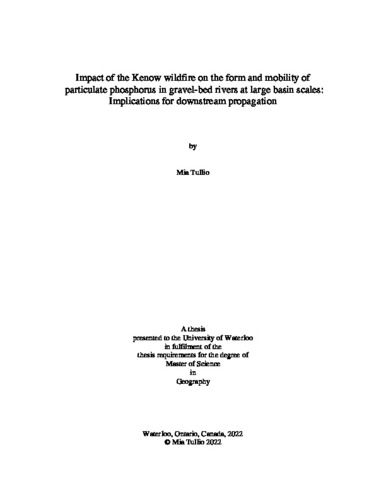| dc.contributor.author | Tullio, Mia | |
| dc.date.accessioned | 2022-05-25 14:40:26 (GMT) | |
| dc.date.available | 2022-05-25 14:40:26 (GMT) | |
| dc.date.issued | 2022-05-25 | |
| dc.date.submitted | 2022-05-16 | |
| dc.identifier.uri | http://hdl.handle.net/10012/18326 | |
| dc.description.abstract | Landscape disturbance by wildfire in forested source water regions can significantly accelerate fine sediment transport from hillslopes to receiving streams. The mobilization of fine sediment and associated nutrients, such as phosphorus (P) into high quality surface waters, which can drastically increase primary production and cause eutrophication, which can severely degrade water quality for ecosystem and human use. In the present study, abiotic controls on the form and mobility of particulate phosphorus (PP) in fine suspended and ingressed river sediment were examined in several oligotrophic gravel-bed rivers in Alberta, Canada, following the 2017 Kenow wildfire. Suspended sediment samples from seven (burned) study sites within Waterton Lakes National Park and three nearby reference rivers draining unburned watersheds were examined from 2018 to 2020 during environmentally sensitive flow conditions, in addition to ingressed sediment samples from burned sites one year post-fire. A sequential extraction scheme and batch equilibrium experiments were conducted to assess the immediate influence of severe wildfire on the form (non-apatite inorganic P, apatite P, organic P) and mobility (equilibrium phosphorus concentration, EPC0) of PP in these systems, respectively. Sediment geochemistry and particle size characteristics were also investigated. Results of the study show that total concentrations of PP and concentrations of bioavailable PP (NAIP) were significantly higher in sediment from rivers draining burned watersheds compared to sediment from rivers in reference watersheds. Elevated bioavailable PP concentrations in burned river sediment were highly correlated with elevated Mn concentrations, which may have been a significant component of pyrogenic material following wildfire. While there were no significant differences in PP mobility between burned and reference river sediment, maximum mean EPC0 values were observed two years after the wildfire, highlighting the potential legacy effect of wildfire disturbance on this key nutrient within rivers. Sediment from both burned and unburned rivers displayed the potential to act as a source of soluble reactive phosphorus (SRP) to the overlying water column, particularly during low flow conditions. Differences in PP form and mobility between burned and reference river sediment were likely influenced by catchment characteristics and in-stream biogeochemical processes. This thesis provides new insights regarding the impact of wildfire and site-specific abiotic processes on the form and mobility of PP in gravel-bed rivers in high quality source water regions. | en |
| dc.language.iso | en | en |
| dc.publisher | University of Waterloo | en |
| dc.subject | wildfire | en |
| dc.subject | gravel-bed rivers | en |
| dc.subject | fine sediment | en |
| dc.subject | particulate phosphorus fractionation | en |
| dc.subject | particulate phosphorus sorption | en |
| dc.title | Impact of the Kenow wildfire on the form and mobility of particulate phosphorus in gravel-bed rivers at large basin scales: Implications for downstream propagation | en |
| dc.type | Master Thesis | en |
| dc.pending | false | |
| uws-etd.degree.department | Geography and Environmental Management | en |
| uws-etd.degree.discipline | Geography | en |
| uws-etd.degree.grantor | University of Waterloo | en |
| uws-etd.degree | Master of Science | en |
| uws-etd.embargo.terms | 0 | en |
| uws.contributor.advisor | Micheal, Stone | |
| uws.contributor.affiliation1 | Faculty of Environment | en |
| uws.published.city | Waterloo | en |
| uws.published.country | Canada | en |
| uws.published.province | Ontario | en |
| uws.typeOfResource | Text | en |
| uws.peerReviewStatus | Unreviewed | en |
| uws.scholarLevel | Graduate | en |

